Themed collection Nanomaterials for printed electronics

Introduction to nanomaterials for printed electronics
Guest Editors Cinzia Casiraghi, Oana D. Jurchescu, Shlomo Magdassi and Wenming Su introduce the themed collection on Nanomaterials for printed electronics.

Nanoscale, 2023,15, 10480-10483
https://doi.org/10.1039/D3NR90072J
3D printed electronics with nanomaterials
This review focuses on the recent advances in the application of nanomaterials for 3D printed electronics, demonstrating conductive paths, electronic and photonic components, energy devices or sensors with perspectives for future developments.

Nanoscale, 2023,15, 5623-5648
https://doi.org/10.1039/D2NR06771D
Reliability of printed stretchable electronics based on nano/micro materials for practical applications
The failure modes when printing stretchable electronics using nano/micro composite ink was summarized and strategies for tackling these challenges to realize reliable performances are proposed and discussed.

Nanoscale, 2023,15, 434-449
https://doi.org/10.1039/D2NR04464A
Printed flexible mechanical sensors
This review analyzes recent developments in the emerging field of printed flexible mechanical sensors. While the field has recently boomed with well performing sensors, systematic ways to print these devices with desired properties are still unclear.
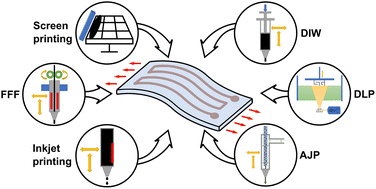
Nanoscale, 2022,14, 17134-17156
https://doi.org/10.1039/D2NR04015H
Transfer printing technologies for soft electronics
This article reviews the strategies and applications of transfer printing techniques for soft electronics, including their working mechanisms and demonstrations in nanomaterial assembly, curvy electronics, bioelectronics and 3D integrated electronics.

Nanoscale, 2022,14, 16749-16760
https://doi.org/10.1039/D2NR04283E
Looking into a crystal ball: printing and patterning self-assembled peptide nanostructures
Recent advances in printing and patterning self-assembled peptide nanostructures are highlighted. Ice lithography, which thus far has not been applied to biological macromolecules, is promising for functionalizing and patterning peptides.
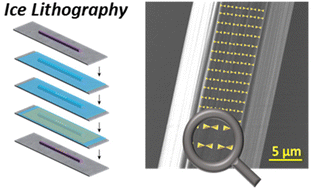
Nanoscale, 2022,14, 15607-15616
https://doi.org/10.1039/D2NR03750E
Integration of nanomaterial sensing layers on printable organic field effect transistors for highly sensitive and stable biochemical signal conversion
The approaches to ameliorate the sensitivity and stability of OFET biochemical sensors have been reviewed, focusing on material and device engineering to enhance the sensing properties of SEs and the transduction efficiency of printable OFET.

Nanoscale, 2023,15, 5537-5559
https://doi.org/10.1039/D2NR05863D
Copper inks for printed electronics: a review
This review summarizes the development of copper inks in printing electronics, including classification of inks, printing and sintering methods, antioxidant strategies, and applications for flexible electronics.

Nanoscale, 2022,14, 16003-16032
https://doi.org/10.1039/D2NR03990G
Enhanced photochemical activity and ultrafast photocarrier dynamics in sustainable synthetic melanin nanoparticle-based donor–acceptor inkjet-printed molecular junctions
Melanin–TiO2 nanostructured molecular junctions with enhanced photochemical dynamics for optoelectronic and bioelectronic applications.
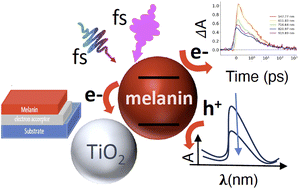
Nanoscale, 2023,15, 14346-14364
https://doi.org/10.1039/D3NR02387G
Chitosan-gated organic transistors printed on ethyl cellulose as a versatile platform for edible electronics and bioelectronics
A platform for edible transistors is presented, comprising a chitosan-based gating medium, an ethylcellulose substrate, and printed gold electrodes.

Nanoscale, 2023,15, 10808-10819
https://doi.org/10.1039/D3NR01051A
Inkjet-printed h-BN memristors for hardware security
Inkjet-printed h-BN memristors exhibit multiple stochastic phenomena that are very attractive for use as entropy sources in electronic circuits for data encryption. The high variability can be exploited to create unique and unpredictable patterns.

Nanoscale, 2023,15, 9985-9992
https://doi.org/10.1039/D3NR00030C
Transfer-printing-enabled GeSn flexible resonant-cavity-enhanced photodetectors with strain-amplified mid-infrared optical responses
A new low-cost, nontoxic, flexible GeSn mid-infrared resonant-cavity-enhanced photodetector with enhanced optical responses via strain and vertical cavity effects is developed to address the need for large-area, integrated mid-infrared flexible optoelectronics.
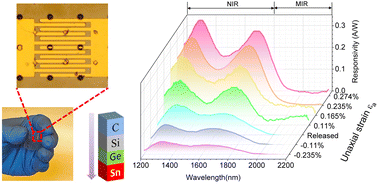
Nanoscale, 2023,15, 7745-7754
https://doi.org/10.1039/D2NR07107J
Aqueous processing of organic semiconductors enabled by stable nanoparticles with built-in surfactants
Non-ionic polar side chains are leveraged in the molecular design of conjugated polymers to create stable surfactant-free polymer nanoparticle dispersions. An organic electronic device is prepared by processing the nanoparticles directly from water.

Nanoscale, 2023,15, 6793-6801
https://doi.org/10.1039/D2NR06024H
Plasma-jet printing of colloidal thermoelectric Bi2Te3 nanoflakes for flexible energy harvesting
Bi2Te3 nanoplates were synthesized to develop a water-based nanomaterial ink for a gravity-independent method of additive manufacturing. By optimization of the plasma-jet printer, deposited N-type thermoelectric legs showed significant flexibility.

Nanoscale, 2023,15, 6596-6606
https://doi.org/10.1039/D2NR06454E
Water-based 2-dimensional anatase TiO2 inks for printed diodes and transistors
TiO2 nanosheets are produced with a mass scalable and F-free bottom-up approach. The material is formulated into a stable water-based ink and exploited in printed diodes and transistors, showing very good dielectric properties.

Nanoscale, 2023,15, 5689-5695
https://doi.org/10.1039/D2NR05786G
Point-of-care (POC) SARS-CoV-2 antigen detection using functionalized aerosol jet-printed organic electrochemical transistors (OECTs)
The continuous spread of coronavirus disease 2019 (COVID-19) has highlighted the need for simple and reliable diagnostic technologies for point-of-care (POC) virus detection applications.
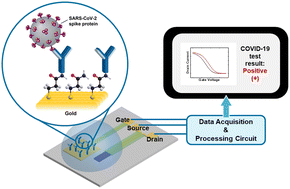
Nanoscale, 2023,15, 5476-5485
https://doi.org/10.1039/D2NR06485E
Printed dry electrode for neuromuscular electrical stimulation (NMES) for e-textile
The flow of the research on screen-printed e-textile with biocompatible materials, which was used for clinical trials on ICU admitted patients and correlated data of clinical and electrochemical impedance studies.

Nanoscale, 2023,15, 5337-5344
https://doi.org/10.1039/D2NR06008F
Large area roll-to-roll printed semiconducting carbon nanotube thin films for flexible carbon-based electronics
A universal roll-to-roll printing approach was developed to achieve large area semiconducting carbon nanotube thin films on flexible substrates, and printed flexible carbon-based electronics exhibited good electrical properties.

Nanoscale, 2023,15, 5317-5326
https://doi.org/10.1039/D2NR07209B
Plasmon enhanced fluorescence from meticulously positioned gold nanoparticles, deposited by ultra sonic spray coating on organic light emitting diodes
The spatial and surface coverage reliance of plasmonic Au nanoparticles is controlled by a roll-to-roll compatible ultrasonic spray coating technique, providing enhanced electroluminescence, luminous efficacy and external quantum efficiency.

Nanoscale Adv., 2023,5, 1750-1759
https://doi.org/10.1039/D2NA00753C
Narrow-bandgap Sn–Pb mixed perovskite single crystals for high-performance near-infrared photodetectors
Herein, a low-temperature space-confined technique (LT-SCT) was developed to fabricate pure-phase (FASnI3)0.1(MAPbI3)0.9 single crystals with excellent optical and electronic properties for high-performance near-infrared photodetectors.

Nanoscale, 2023,15, 5053-5062
https://doi.org/10.1039/D2NR05800F
A sprayed graphene transistor platform for rapid and low-cost chemical sensing
Lab-on-printed circuit board platform for scalable electrochemically-gated graphene field effect transistors test strips, measuring pH and Na+ ion concentration.
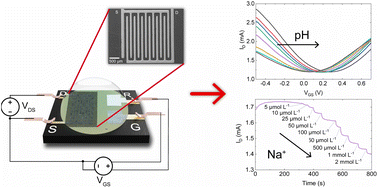
Nanoscale, 2023,15, 3243-3254
https://doi.org/10.1039/D2NR05838C
All-printed and stretchable organic electrochemical transistors using a hydrogel electrolyte
All-printed organic electrochemical transistors based on a hydrogel electrolyte show high stretchability and long term stability.
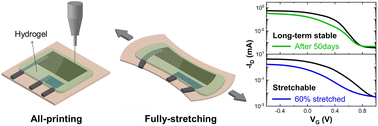
Nanoscale, 2023,15, 3263-3272
https://doi.org/10.1039/D2NR06731E
Eco-friendly screen printing of silver nanowires for flexible and stretchable electronics
This paper reports an eco-friendly method for screen printing of silver nanowires on a diverse range of substrates with high resolution and high electric conductivity. A low annealing temperature makes the method compatible with plastic substrates.

Nanoscale, 2023,15, 2767-2778
https://doi.org/10.1039/D2NR05840E
Hardware implementation of a true random number generator integrating a hexagonal boron nitride memristor with a commercial microcontroller
A 2D hexagonal boron nitride (h-BN) memristor with inkjet-printed silver electrodes is fabricated for ultra-stable random telegraph noise and connected to a custom, low-cost true random number generator fabricated using commercial components.

Nanoscale, 2023,15, 2171-2180
https://doi.org/10.1039/D2NR06222D
Humidity sensors based on molecular rectifiers
This article reports on humidity sensors based on molecular rectifiers. Their operation relies on modifications in the height and shape of the tunneling barrier upon absorption of water molecules.

Nanoscale, 2023,15, 171-176
https://doi.org/10.1039/D2NR04498F
Hybrid nanomaterial inks for printed resistive temperature sensors with tunable properties to maximize sensitivity
Flexible resistive temperature sensors with tunable temperature coefficient of resistance and sensitivity fabricated by aerosol jet printing with hybrid nanomaterial inks.

Nanoscale, 2023,15, 162-170
https://doi.org/10.1039/D2NR04005K
Competing single-chain folding and multi-chain aggregation pathways control solution-phase aggregate morphology of organic semiconducting polymers
Using computer simulations and theory, we explain the unexpected formation in poor solvents of extended rod-like semiconducting-polymer aggregates, which are correlated with enhanced electron mobility but are not predicted by existing theories.

Nanoscale, 2022,14, 18070-18086
https://doi.org/10.1039/D2NR04750K
Gas-assisted blade-coating of organic semiconductors: molecular assembly, device fabrication and complex thin-film structuring
Incorporating gas-assisted drying with laboratory-scale blade-coating of organic semiconductors yields full performance parity with spin-coated devices and enables simultaneous spatial patterning of active layer microstructure.

Nanoscale, 2022,14, 17743-17753
https://doi.org/10.1039/D2NR05947A
Achieving efficient and stabilized organic solar cells by precisely controlling the proportion of copolymerized units in electron-rich polymers
Random polymers with different surface electrostatic potential were obtained by introducing the structural units of polymer PM6 into the polymer structure as the third unit, providing a new perspective for the molecular design of random polymer.

Nanoscale, 2022,14, 17714-17724
https://doi.org/10.1039/D2NR03992C
In situ interfacial passivation with an arylphosphine oxide and phosphonate electron transporting layer for efficient all-solution-processed PeQLEDs
All-solution-processed PeQLEDs are developed by interfacial passivation with an electron transporting material containing a P![[double bond, length as m-dash]](https://www.rsc.org/images/entities/char_e001.gif) O group, revealing bright green emission with a promising external quantum efficiency (EQE) of 6.47%.
O group, revealing bright green emission with a promising external quantum efficiency (EQE) of 6.47%.

Nanoscale, 2022,14, 17230-17236
https://doi.org/10.1039/D2NR03793A
Hydrogel-based printing strategy for high-performance flexible thermoelectric generators
The hydrogel-based printing strategy was proposed to fabricate the high-performance flexible thermoelectric generators with the high-power density, where the stable water-locking network can limit the fluidity of the pastes.
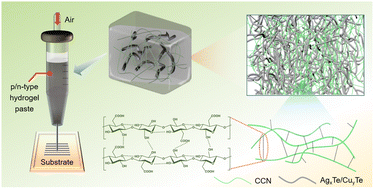
Nanoscale, 2022,14, 16857-16864
https://doi.org/10.1039/D2NR05733F
Ionic dielectrics for fully printed carbon nanotube transistors: impact of composition and induced stresses
Ionic gate dielectrics for all-printed CNT-TFTs show promise for low-voltage operation and this work reveals important trade-offs in performance and stability based on composition.
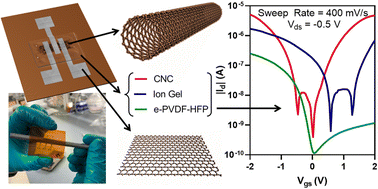
Nanoscale, 2022,14, 16845-16856
https://doi.org/10.1039/D2NR04206A
Multiplexed printed sensors for in situ monitoring in bivalve aquaculture
Non-intrusive sensors that can be attached to marine species offer opportunities to study the impacts of environmental changes on their behaviors and well-being.
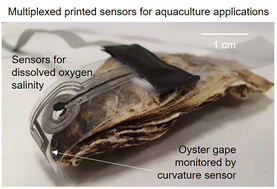
Nanoscale, 2022,14, 16110-16119
https://doi.org/10.1039/D2NR04382C
Solution processed, vertically stacked hetero-structured diodes based on liquid-exfoliated WS2 nanosheets: from electrode-limited to bulk-limited behavior
Solution-processed vertical metal–semiconductor-metal devices are fabricated with liquid-exfoliated tungsten disulfide nanosheets, which exhibit bulk- or electrode-limited behaviors depending on the details of the top electrode.

Nanoscale, 2022,14, 15679-15690
https://doi.org/10.1039/D2NR04196K
Visualisation of individual dopants in a conjugated polymer: sub-nanometre 3D spatial distribution and correlation with electrical properties
The 3D sub-nanometre distribution of individual dopant species in organic semiconductors determines the electrical properties. The distribution and cluster shape have been determined by electron tomography and shown to depend on dopant concentration.
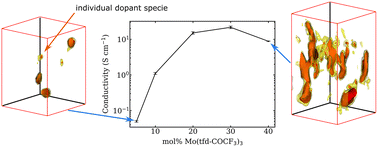
Nanoscale, 2022,14, 15404-15413
https://doi.org/10.1039/D2NR03554E
Printing nanoparticle-based isotropic/anisotropic networks for directional electrical circuits
An efficient prototype for manufacturing the isotropic/anisotropic circuits is demonstrated through the template-assisted printing strategy, which achieves a remarkable on/off ratio over 1011.

Nanoscale, 2022,14, 14956-14961
https://doi.org/10.1039/D2NR03892G
High performance printed organic electrochromic devices based on an optimized UV curable solid-state electrolyte
High-performance fully printed organic electrochromic devices were realized based on an optimized UV curable solid-state electrolyte.

Nanoscale, 2022,14, 14122-14128
https://doi.org/10.1039/D2NR03209K
Networks of as-dispersed, polymer-wrapped (6,5) single-walled carbon nanotubes for selective Cu2+ and glyphosate sensing
Networks of semiconducting single-walled carbon nanotubes (SWNTs) are used as the transducing layer for sensors based on water-gated transistors.
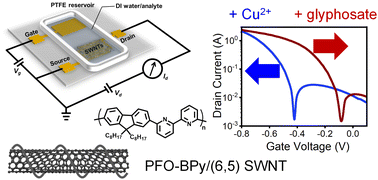
Nanoscale, 2022,14, 13542-13550
https://doi.org/10.1039/D2NR02517E
Titanium hydride nanoparticles and nanoinks for aerosol jet printed electronics
Titanium hydride nanoinks are made by ball milling activated powders and tuned for aerosol jet printing. Photonic curing sinters nanoparticles to improve electrical conductivity, providing a viable route to diverse functionality in printed devices.

Nanoscale, 2022,14, 12651-12657
https://doi.org/10.1039/D2NR03571E
Flexible and transparent electrodes imprinted from metal nanostructures: morphology and opto-electronic performance
Plasma sintering particle-based Au grids yields conductors with Au shell and hybrid core. Defects that dominate the performance change with particle concentration and type. Wires are less prone to disruptive defects and thus outperform spheres.

Nanoscale Adv., 2022,4, 3370-3380
https://doi.org/10.1039/D2NA00259K
About this collection
Guest Edited by Professor Cinzia Casiraghi (University of Manchester, UK), Professor Oana Jurchescu (Wake Forest University, USA), Professor Shlomo Magdassi (Hebrew University of Jerusalem, Israel) and Professor Wenming Su (Suzhou Institute of Nano-Tech and Nano-Bionics, China).
Printed electronics have witnessed significant interest within the last few decades, in particular in conjunction with the development of the Internet of Things (IoTs). The digitization of machines, vehicles, and elements of the physical world could completely change the way we interact with objects and collect and get access to data, leading to improved quality of life and reduced costs. Nanomaterials present unique physicochemical properties that make them perfect to be used as functional inks for the fabrication of printed devices. This collection brings together different types of nanomaterials for printed electronics (organic, inorganic, hybrids, etc.) and provides an overview on the most used technologies for printed electronics, with the aim of connecting different communities and identifying common challenges in the field.